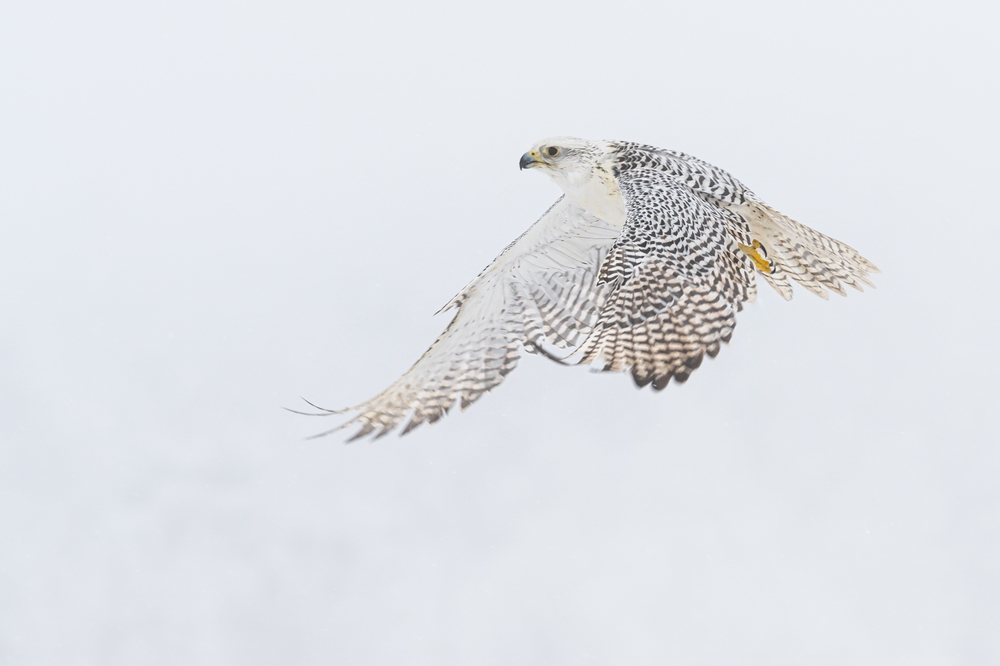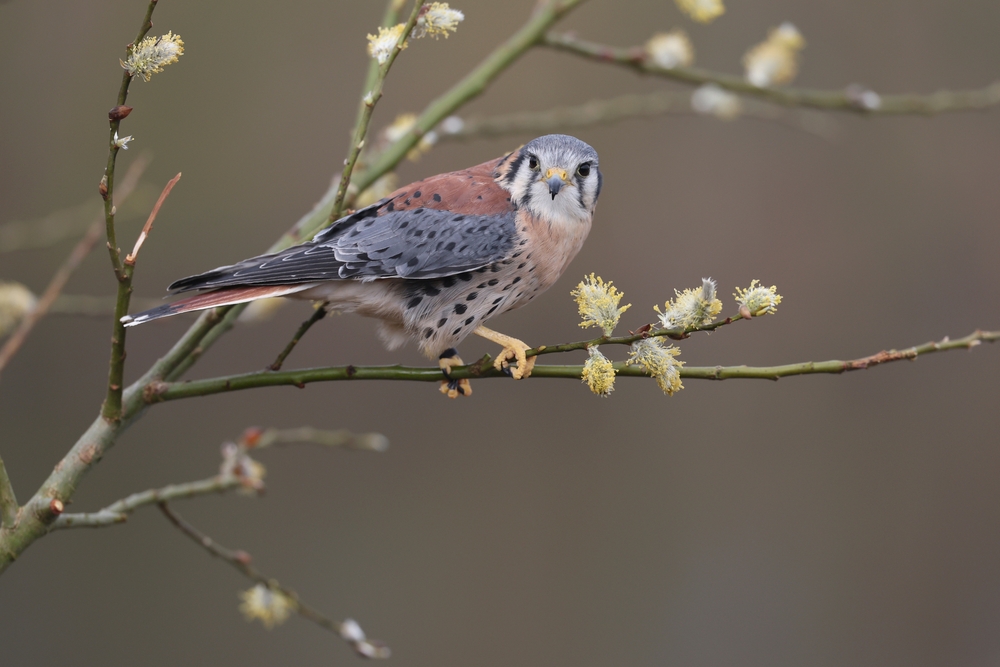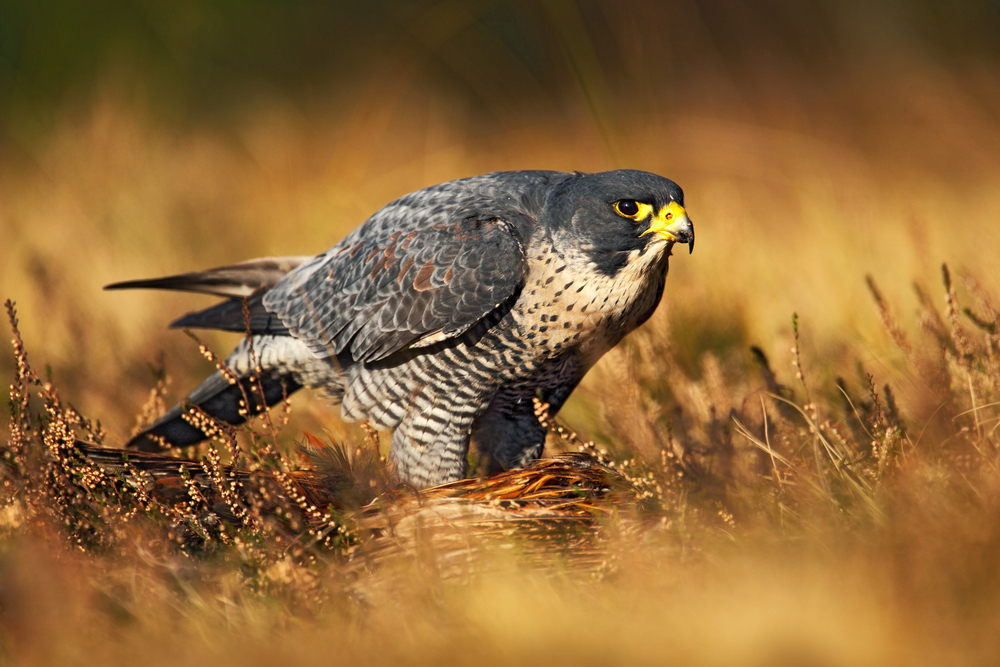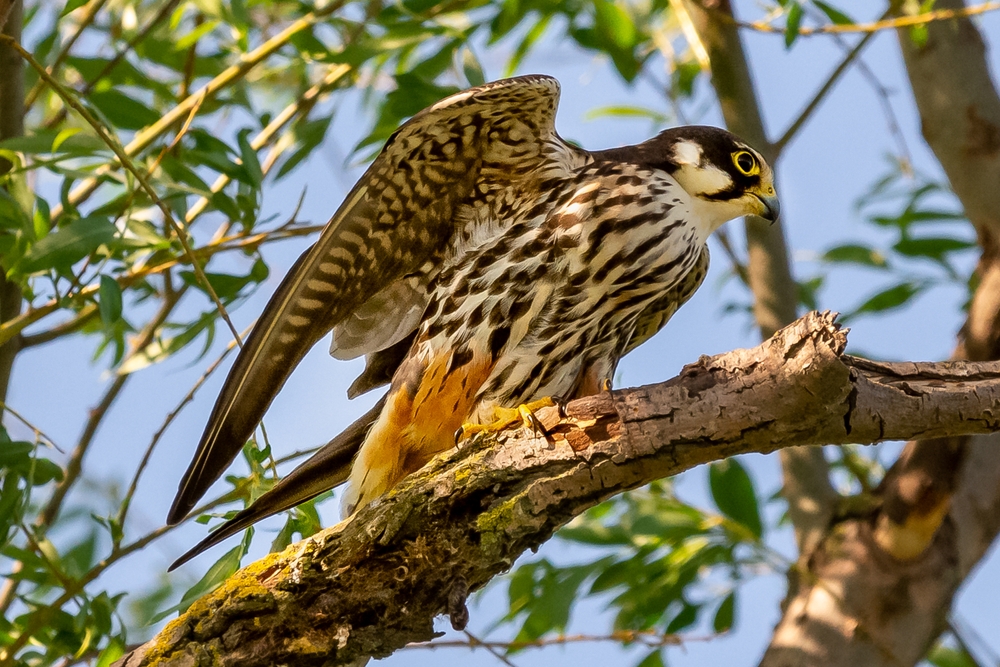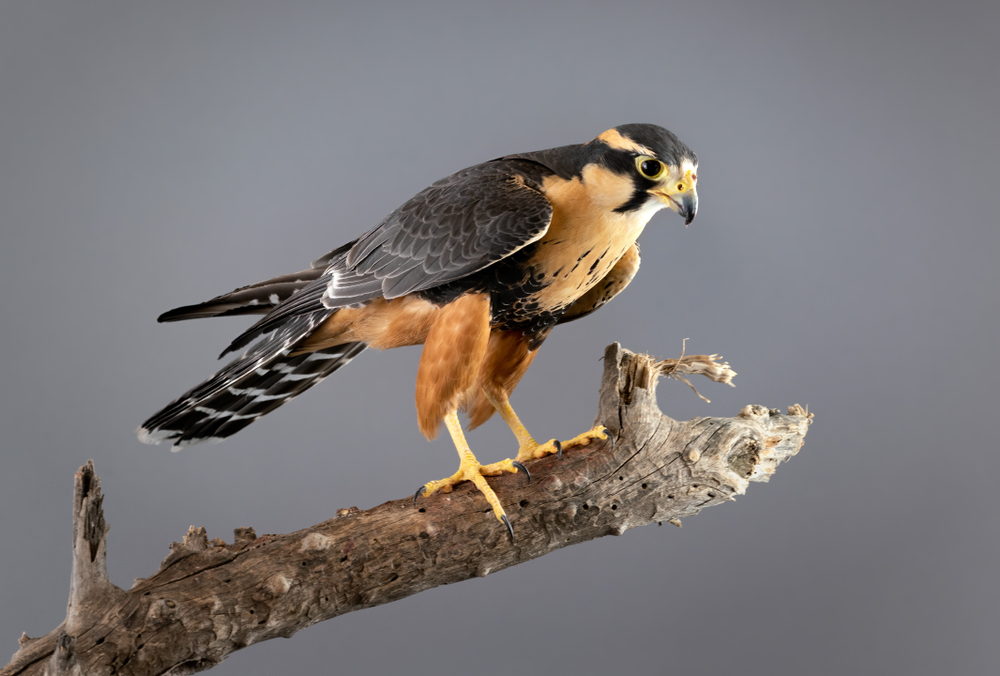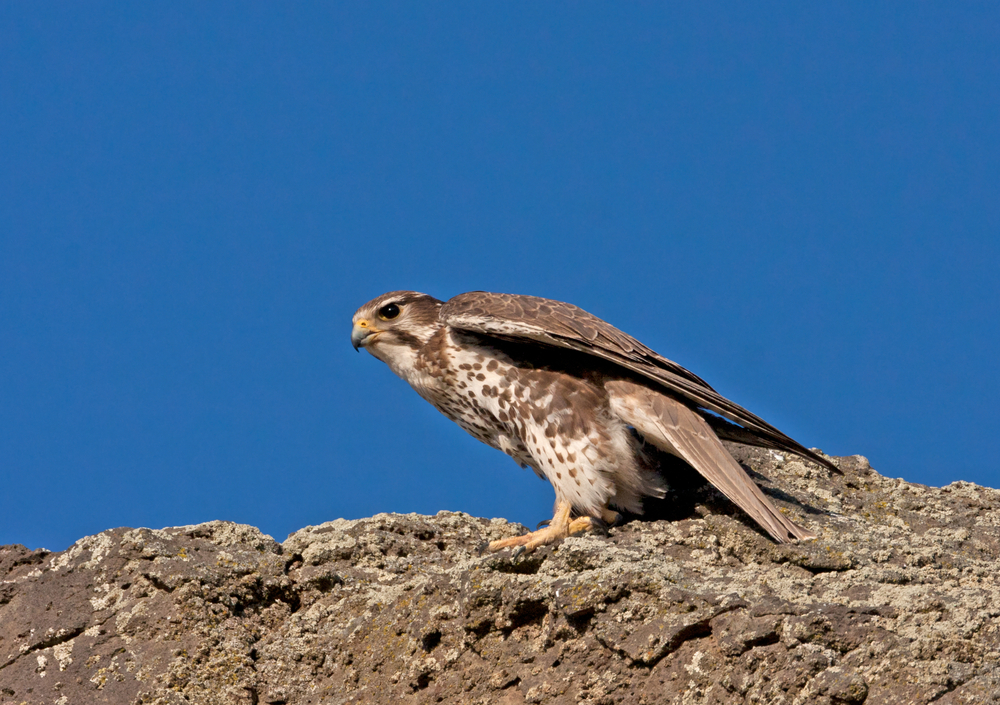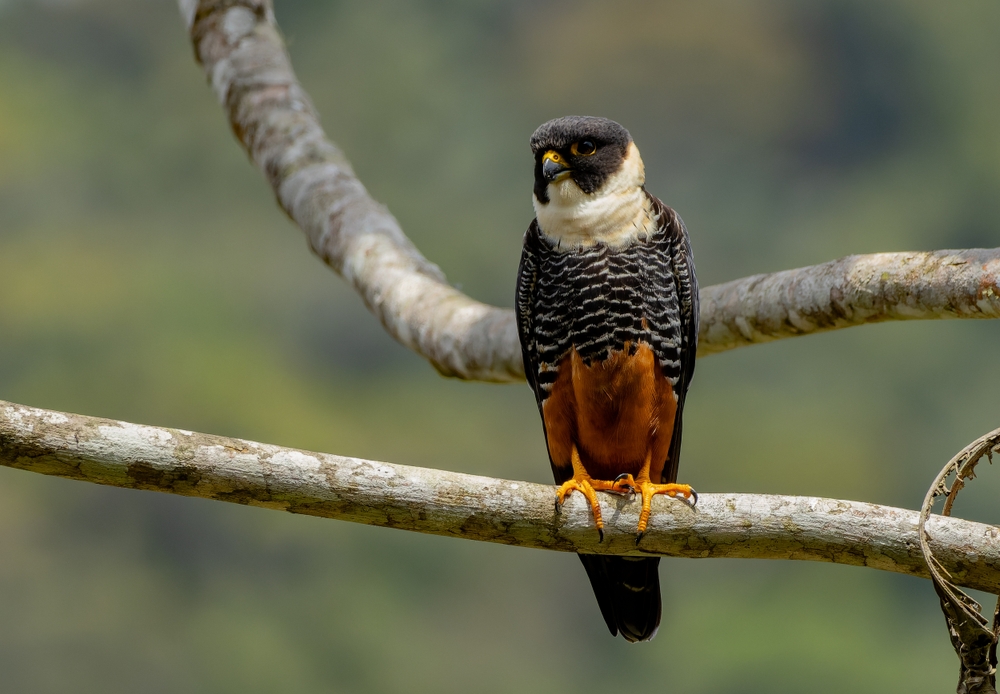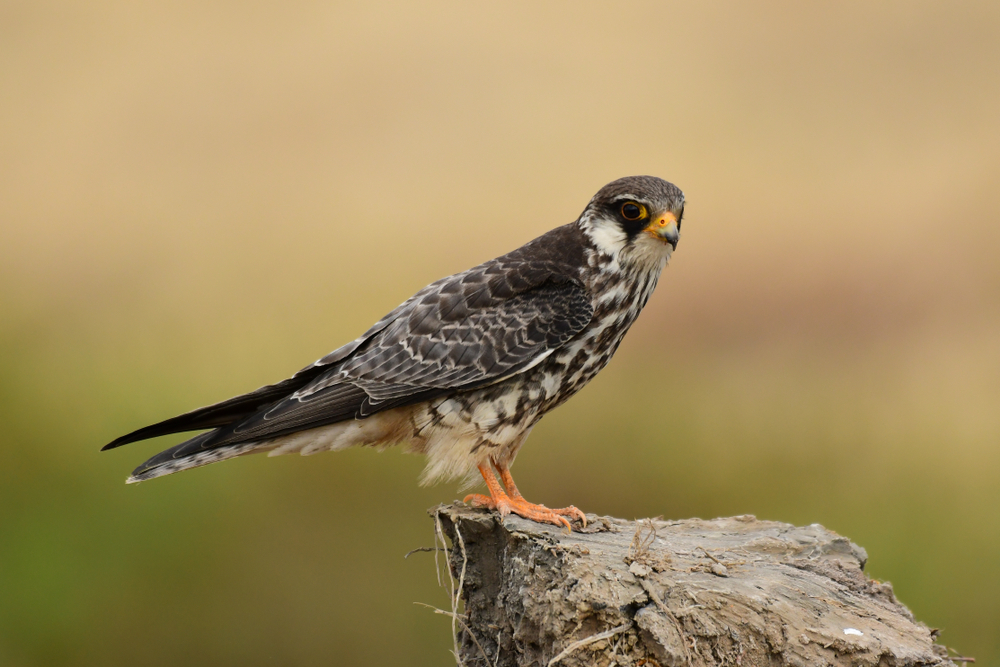The Gyrfalcon (Falco rusticolus) is most closely related to the Peregrine Falcon (Falco peregrinus) and the Saker Falcon (Falco cherrug), both sharing similarities in size, hunting strategies, and evolutionary lineage.
About
The Gyrfalcon (Falco rusticolus), belonging to the family Falconidae, is the largest and most powerful falcon in the world. Native to Arctic and subarctic regions, it inhabits tundra, cliffs, and coastal areas across North America, Europe, and Asia. This magnificent raptor is renowned for its impressive size, strength, and hunting prowess, often considered the “king of falcons.”
Adult Gyrfalcons exhibit a wide range of plumage variations, from nearly pure white to dark gray and brown morphs. This diversity in coloration provides camouflage in snow-covered, rocky, or tundra landscapes. They are robust birds, with long, pointed wings and a powerful build, enabling both high-speed pursuits and explosive bursts of power when capturing prey. Females, as with most raptors, are larger than males, with wingspans reaching up to 160 cm (63 in).
Diet consists mainly of medium-sized birds such as ptarmigan and waterfowl, though they will also take mammals like hares. Unlike peregrines, which often hunt by high-speed stooping dives, Gyrfalcons typically rely on direct pursuit and relentless stamina, chasing prey over long distances until it weakens.
Breeding occurs in remote, rugged habitats. Gyrfalcons nest on cliff ledges or sometimes old nests of other large birds. A clutch usually contains 2–5 eggs, with both parents fiercely defending their young. Because of their harsh environment, reproduction success can vary greatly depending on prey abundance.
The species holds cultural and historical significance; for centuries, white Gyrfalcons were prized by royalty and nobility in Europe and the Middle East as symbols of prestige and power. Today, they remain highly valued in falconry while being protected as a vulnerable Arctic predator facing challenges from climate change, habitat shifts, and human disturbances.
Physical Characteristics
The Gyrfalcon (Falco rusticolus) is the largest falcon in the world, renowned for its size, power, and striking plumage variations.
Plumage:
-
Color Morphs: Gyrfalcons occur in three main morphs—white, gray, and dark—with many variations in between.
-
White Morph: Mostly white with dark streaks, giving a snowy appearance.
-
Gray Morph: Slate-gray upperparts with fine barring on the chest and belly.
-
Dark Morph: Dark brown overall, with lighter mottling and streaking underneath.
-
-
All morphs have yellow legs, feet, and cere (the fleshy base of the beak).
Head and Face:
The head is large and rounded, with a short, powerful, hooked beak. Unlike many falcons, the Gyrfalcon lacks a prominent “moustache” stripe, giving it a more uniform facial appearance.
Body and Wings:
The Gyrfalcon has a robust, broad-chested body with long, pointed wings. While less tapered than those of a Peregrine, the wings are powerful and suited for strong, sustained flight rather than stooping dives.
Tail:
The tail is long and slightly rounded, heavily barred, and plays a key role in maneuverability during pursuit chases over tundra and open landscapes.
Size:
-
Length: 19–25 in (48–64 cm)
-
Wingspan: 43–51 in (110–130 cm)
-
Height at Rest: About 20 in (51 cm) when perched
Weight:
-
Adult Male: 1.8–3.1 lbs (800–1,400 g)
-
Adult Female: 2.2–4.6 lbs (1,000–2,100 g)
The Gyrfalcon’s large size, variable plumage, and powerful build make it one of the most distinctive and awe-inspiring raptors of the Arctic and subarctic regions.
Reproduction
The Gyrfalcon (Falco rusticolus) breeds in remote Arctic and subarctic regions, with a reproductive cycle adapted to short summers and harsh climates.
1. Mating and Courtship:
Gyrfalcons are monogamous, often forming long-term pair bonds that may last for life. Courtship includes spectacular aerial displays, soaring flights, and food offerings from the male to the female.
2. Nesting Sites:
They do not build their own nests. Instead, Gyrfalcons use cliff ledges, rocky outcrops, or abandoned nests of ravens, golden eagles, or other large birds. Nest sites are chosen for safety, wide visibility, and proximity to hunting grounds.
3. Egg Laying:
The female lays 2–5 eggs per clutch, usually in May or early June, timed with increasing prey availability. Eggs are buff or reddish-brown, mottled with darker markings.
4. Incubation:
Incubation lasts 34–36 days, with the female doing most of the brooding while the male hunts and delivers prey.
5. Hatching and Care of Chicks:
Chicks hatch covered in white down and weigh around 1.5–2 oz (40–60 g). The female broods the young intensively for the first two weeks, while the male continues to provide food. As chicks grow, both parents contribute to feeding.
6. Fledging and Independence:
Nestlings fledge at about 45–50 days of age. After fledging, juveniles stay near the nest site and rely on their parents for food and protection for several additional weeks until they learn to hunt.
7. Breeding Frequency:
Gyrfalcons usually raise one brood per year, though some pairs may skip breeding if prey (such as ptarmigan) is scarce.
The Gyrfalcon’s breeding success is closely tied to prey cycles in the Arctic, particularly ptarmigan populations. Their strong pair bonds, large clutch sizes, and extended parental care improve chick survival in an extreme environment.
Lifespan
The Gyrfalcon (Falco rusticolus) has a relatively long lifespan for a raptor, reflecting its size, strength, and dominance in Arctic ecosystems.
Lifespan in the Wild:
In the wild, Gyrfalcons typically live 12–16 years on average. However, many juveniles fail to survive their first year due to starvation, harsh weather, or predation. The oldest recorded wild Gyrfalcon lived over 19 years.
Lifespan in Captivity:
In captivity, where food and veterinary care are consistent, Gyrfalcons can live 20 years or more, with some individuals reaching 25 years.
Threats to the Gyrfalcon:
-
Prey Cycles: Their survival is closely tied to the abundance of ptarmigan and waterfowl; population crashes in prey can reduce breeding success.
-
Harsh Climate: Severe winters and unpredictable Arctic weather increase juvenile mortality.
-
Predation: Eggs and chicks may be taken by ravens, eagles, or foxes, though adults face few natural predators.
-
Human Activity: Disturbance from mining, oil exploration, and aircraft in remote regions may disrupt nesting.
-
Climate Change: Shifts in prey availability, melting permafrost, and habitat change threaten long-term survival.
Conservation measures focusing on habitat protection, prey monitoring, and minimizing human disturbance are critical for sustaining Gyrfalcon populations in the fragile Arctic environment.
Eating Habits
The Gyrfalcon (Falco rusticolus) is a powerful predator, relying on strength and endurance rather than extreme speed, making it well-suited to the open Arctic landscapes where it lives.
Diet:
-
Birds: Primary prey includes ptarmigan, grouse, waterfowl, gulls, and seabirds. Ptarmigan are especially critical, often making up the majority of their diet.
-
Mammals: Occasionally hunt lemmings, hares, ground squirrels, and other small to medium-sized mammals.
-
Other Prey: Opportunistically feed on carrion or steal prey from other raptors when necessary.
Hunting Strategy:
-
Pursuit Hunting: Unlike Peregrine Falcons, which stoop at high speeds, Gyrfalcons favor long, level chases, using their powerful wingbeats to overtake prey.
-
Surprise Attacks: They may ambush prey from perches, cliffs, or by flying low across terrain before striking.
-
Aerial Skill: Capable of high-speed pursuits, though their strength and stamina are emphasized more than short bursts of speed.
Feeding Behavior:
-
Prey is usually killed swiftly with a strong bite to the neck or head.
-
Larger prey may be plucked before being consumed, while smaller prey is eaten more quickly.
-
During breeding, males capture and deliver prey to females and chicks, often caching excess food near the nest.
Success and Adaptability:
The Gyrfalcon’s dominance in Arctic food webs comes from its size, power, and adaptability. By specializing in ptarmigan but also shifting to alternative prey when needed, it survives in one of the harshest climates on Earth.
Uniqueness
The Gyrfalcon (Falco rusticolus) is an extraordinary bird of prey, distinguished as the largest and most powerful falcon in the world.
Largest Falcon:
With females reaching nearly 4.5 lbs (2.1 kg), the Gyrfalcon is significantly larger than Peregrines, giving it dominance among falcons and allowing it to capture prey nearly its own size.
Color Morph Diversity:
Gyrfalcons occur in striking color variations—white, gray, and dark morphs—ranging from pure snowy-white birds of Greenland to dark brown individuals of Arctic coasts. This polymorphism is rare among falcons and contributes to their mystique.
Strength over Speed:
Unlike Peregrine Falcons that rely on high-speed stoops, Gyrfalcons use endurance and brute power to chase down and overwhelm prey, a strategy well-suited to the Arctic’s open tundra.
Arctic Specialist:
They breed in some of the harshest environments on Earth, nesting on cliffs and hunting across vast, treeless landscapes dominated by snow, ice, and extreme cold.
Cultural and Historical Significance:
Highly prized in ancient falconry, white Gyrfalcons were symbols of royalty and wealth in medieval Europe and the Middle East, often gifted among kings and emperors.
Ecological Role:
By controlling ptarmigan and seabird populations, Gyrfalcons are vital apex predators in fragile Arctic ecosystems. Their survival reflects the health of northern environments.
The Gyrfalcon’s immense size, color variety, cultural importance, and adaptation to the Arctic wilderness make it one of the most iconic and unique raptors in the world.
Be the First to Share Photos of This Species.
FAQ’s
1. What is the species closest to the Gyrfalcon?
2. How does the Gyrfalcon compare to other falcons?
The Gyrfalcon is the largest and heaviest falcon, built for power and endurance rather than speed. Unlike Peregrines, which use high-speed stoops, Gyrfalcons pursue prey in long, powerful chases across open tundra, often targeting ptarmigan and waterfowl.
3. Which national parks provide the best opportunities to see a Gyrfalcon?
Which national parks provide the best opportunities to see a Gyrfalcon?
-
Vatnajökull National Park (Iceland): A prime stronghold where white and gray morphs are seen hunting seabirds.
-
Wapusk National Park (Canada): Offers sightings of Gyrfalcons in Arctic tundra habitat.
-
Quttinirpaaq National Park (Canada): One of the northernmost breeding areas for this species.
-
Northeast Greenland National Park (Greenland): Vast wilderness home to white-morph Gyrfalcons.



































































